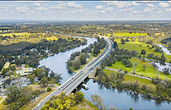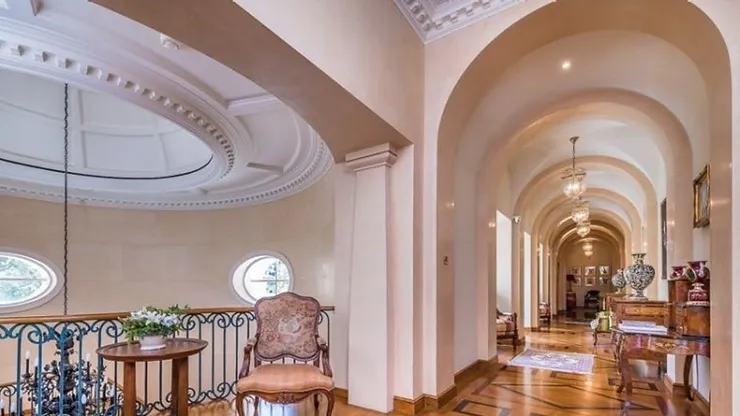The big end of town. Opulence worthy of royalty.
Jutland Parade and Dalkeith became synonymous with WA’s opulent 80s when some of the state’s most famous entrepreneurs – including Alan Bond – moved into the area. To live there today, neighbours include media giant Kerry Stokes and, around the corner, Gina Rinehart.
20 Jutland Parade is one of Perth’s finest mansions, built by Bond Corp director Peter Beckwith in the late 1980s. Mr Beckwith lived there with wife Valerie for only a short time before his untimely death in 1990.
Since then a raft of high-flyers have enjoyed the charms of the Italian villa, including Wildcats owner Jack Bendat and Sonic Healthcare’s Michael Boyd. In 2004 Mr Boyd subdivided the mansion’s riverfront croquet garden and sold it off for $5.6 million.
See two ancient worlds collide at Dalkeith’s staggering 26 Jutland Parade, a gargantuan property boasting a masterful blend of Greek and Roman architecture. Standing proud on a 2372sqm plot, the Georgian-inspired palace edges the Swan River and turns heads from the outset with its royal size and otherworldly aesthetic. Borrowing a range of features from empires of yesteryear, each nook and cranny will leave homeowners feeling as if they are touring Italy’s Colosseum.
In 2017 there were 10 new houses in varying stages of construction on the 700m street in Dalkeith — once home to 1980s high rollers such as entertainment king Michael Edgley and Jeans West boss Alister Norwood. A rare upswing of activity for the otherwise reasonably quiet street.
Adding to the colourful array of residents, billionaire Sultan Ibrahim Ismail of Johor who built his holiday mansion, finished in 2020, at the end of Jutland Parade, on a block officially listed as Iris Avenue. The five-storey compound built on on a riverfront property owned by Mario and Maggie Franco set a record as Perth’s biggest home, and is so large it feels like it needs its own postcode. The build area for the home and its 16-car undercroft carpark and boat shed is 3400sqm, which is 12 times the size of the average home. It has seven bedrooms, three kitchens and eight bathrooms.
The amount of money, just centred around the land once one of these properties becomes available, is staggering. Numbers with seemingly infinite zero’s. That said, a fantastic place to daydream about…
what if?
Todays Good Reads
Guns, ammo and freedom.
It looks like our American cousins want change, but the stats don’t bode well for change.
Sustainable ideals provide sustained results.
One South Australian family, sees positive results from a different approach to the land.
The Binge Files: Moon Knight… worth it?
This tough but fair review on the finale of the series is a fun way to work out it the show is for you.

Pine plantations: No longer part of Perth’s future?
The Forest Products Commission (FPC) has more than 100,000 hectares of plantations under its management. The main plantation species used by industry are radiata pine (Pinus radiata) and maritime pine (Pinus pinaster). These are softwood species that have been planted over many years to help reduce Australia’s reliance on imported timbers. Other plantations include WA sandalwood (Santalum spicatum) and various eucalypt species. FPC managed plantations are located over a broad geographic area that extends from Moora in the north to Esperance in the south.
Pine plantations were established to meet the State’s expanding demand for structural timber. The softwood plantation sector in Western Australia contributes to the more than $1.4 billion per year generated by the forest industry and supports the employment of more than 1,900 people.
The managed pine is on state-owned and managed land and tree farms on leased farmland. The primary commercial products are pine sawlog and pine industrial wood logs. The plantations provide the resource for three main processing plants – Wespine sawmill at Dardanup, Wesbeam laminated veneer lumber (LVL) just north of Perth and particleboard production at the Laminex site in Dardanup. The supply of pine resource to all three major processing plants is under State Agreement Acts with terms of 25 years.
That said, many draft proposals have advocated moving pine plantations out of the metro footprint and refocussing efforts elsewhere. A draft Perth and Peel Green Growth Plan for 3.5 million, was out for public comment, outlined the future of the Yanchep and Pinjar plantations in the City of Wanneroo, and the Gnangara plantation in the City of Swan. “This action plan provides guidance on the implementation of the harvesting of pines,” the plan said.
“It describes future land uses for the Gnangara, Pinjar and Yanchep pine plantations situated over the Gnangara Mound within State Forest 65 and the ongoing land use and management of the area post-harvest.” Under review every five years, the action plan said the pine plantations were established between 1932 and 1994 for timber production.
Classified as State Forest, they are vested with the Conservation Commission of Western Australia (CCWA) and managed by the Department of Parks and Wildlife.The Forest Products Commission (FPC) has harvesting rights while commercial pine is present, which Wesbeam is harvesting under the Wood Processing (Wesbeam) Agreement Act 2002.
“In 1996, the State Government decided to remove up to 23,000ha of pines at the Gnangara, Pinjar and Yanchep plantations and not replace them in order to increase water recharge on the Gnangara Mound,” the draft document said.
“Water recharge to the Gnangara Mound, and hence groundwater supply, is important for almost half of the public drinking water supply in Perth as well as for supporting groundwater dependent ecosystems.
“Removing the pines was one strategy to offset the impacts of the drying climate, helping maintain the long term productivity of the water resource, particularly meeting water needs for a population of 3.5 million.”
Content with more content
Now if you prefer to consume your information through audio instead of through text (which is understandable) come and check out or podcast which lives here. It is a show we are doing weekly which has a nice blend of education and entertainment aimed at the prospective homebuyer.





